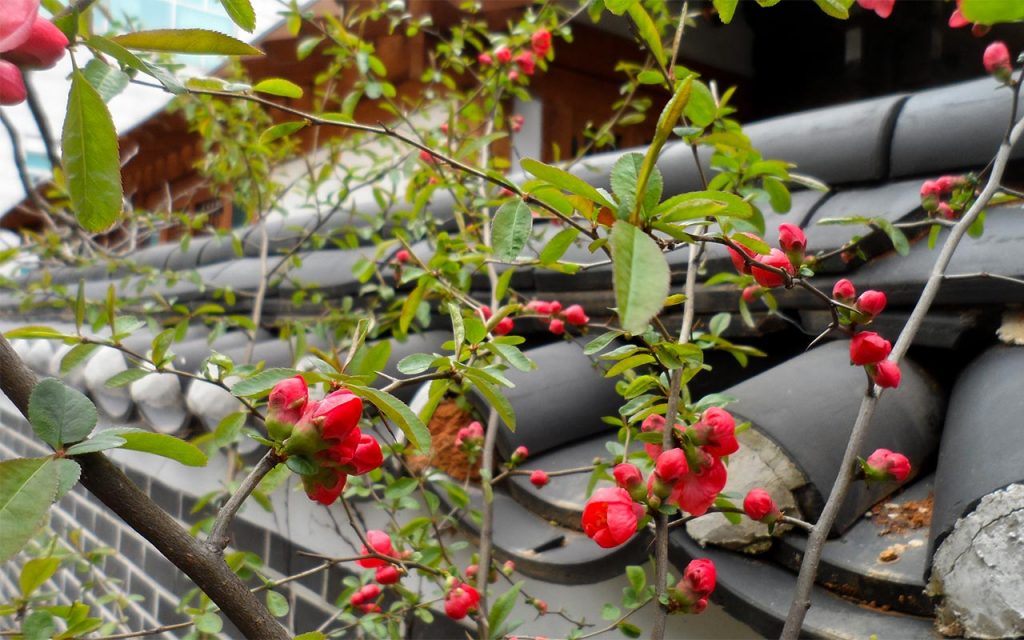Jeonju was the place I most wanted to visit in South Korea and I had marked loads of things I wanted to see and do in my guide book. On trying to book the accommodation I desperately wanted to stay at, Seunggwangje, I discovered someone’s blog about Jeonju and it roused some suspicions that, yet again, the guide book might have been bigging somewhere, ie Jeonju, up. In his blog, he explained it was difficult to book a room there and, well, it all sounded complicated and something of a damp squib, both the guest house and Jeonju. So at least I was prepared for potential disappointment.

Why go
Well-preserved hanok village.
Lots of trendy and quirky cafes and loads of craft and souvenir shops.
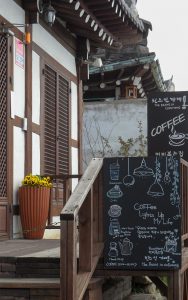
Jeonju is the birthplace of bibimbap (indeed we had our best ever bibimbap meal there).
Is it worth going out of your way to visit?
I struggle with a straight answer to this. But yes to see the hanok village and all the craft shops. But no if you are on a budget and don’t like merely window shopping. It’s actually one of the most expensive places I’ve ever been in terms of coffees and craft shops.
It is of historical interest and the hanok village area is interesting (it’s one great big tourist theme park, though not as kitsch or cheap as some). But a lot of the buildings are newly built.
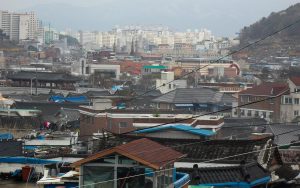
The Gaeksa district, largely covered shopping streets but some interesting side alleys and nice-looking cafes and bars, which is kind of across the main road and along from the hanok village, is more normal in terms of prices and it’s actually ok for a “new” town. It’s quite young and hip, as reflected in the kinds of shops, mainly clothing. There are even roads named for what they sell, eg a road dedicated to all things wedding-related.
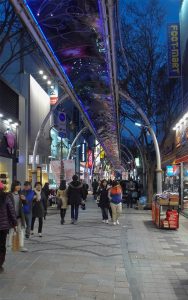
I wouldn’t go again because it was too touristy and overpriced but I’m glad we went. However, after it feeling like quite a big area the afternoon we arrived, we were looking forward to the whole following day in Jeonju. It transpires it’s a really small area (hanok village AND Gaeksa) of a large town.
As for the craft shops, the guide books made the shopping area in the hanok village sound idyllic, with talk of a craft treasures centre, “a large complex of shops that sell lanterns, boxes, ties, clothing and paper products”. Large? Really? It was small and disappointing. Yes, if you like paper goods, pottery and good quality hand made crafts, you will find such things. But everything I liked was too expensive for me to entertain the idea of buying.

I had saved my craft shopping for Jeonju so I really wanted to buy something. I had particularly wanted something made from hand made paper. For about 50,000 won (£32), I bought a paper lantern with a bulb. I didn’t think that was a bargain though.
Jeonju Hanok Maeul
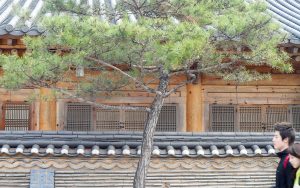
The guide book talked of a Korean Paper Institute, a calligraphy museum, a wine museum … but all disappointed me.
We couldn’t find the Korean Paper Institute. Or rather, I think we found it but it wasn’t entirely open. A small shop was open though, which was nice as it was a kind of paper rummage type shop.
The calligraphy museum was in an uninspiring building and there were no English translations so it was difficult to appreciate the calligraphy. It was also more formal than I’d expected.
The wine museum was sold to us as offering soju tasters but there wasn’t a drop to try. The museum was in a nice old building, it was free and it showed how soju is made.
Pungnam-mun, “an impressive stone-and-wood gateway”, the only remnants of Jeonju’s fortress wall, I’m sorry to say, wasn’t worth visiting. The gateway is essentially the middle of a roundabout and, if you’ve visited historic sites prior to Jeonju, you’ll have seen similar structures elsewhere (sorry, I don’t mean to sound blase but that’s kind of how we felt).
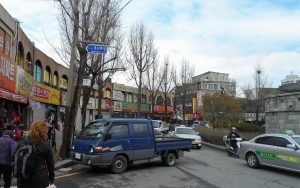
I reiterate it is very expensive. We had a coffee (admittedly very good) and a hot chocolate (also good) in one of the new, trendy cafes (incidentally in an ugly, modern building in the heart of the historic old town). It came to 14,000 (£9). I would never pay £4.50 for a coffee in the UK even. In fact, I believe even Copenhagen was cheaper.
There are more non-traditional buildings within the hanok village area than I expected.
Beyond the two main roads through the village and the alleyways linking the two, there’s not much more to see. The impression I’d received from the guide book didn’t at all match what I saw there. But it is nice.
The Gaeksa area is interesting to walk around and I quite liked all the graffiti and wall decorations we saw, and also some quirky cafes – on the hanok village side of Paldal-ro, up towards Wedding Street and heading across to Gaeksa, from there and around Film Street.
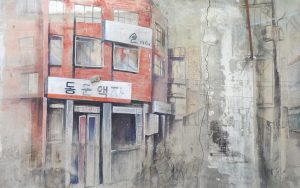
Practical information
Our guide book said hanok guest houses were all c 50,000 won (£32). We couldn’t find any for less than 80,000. In the end, having ruled out one we went to see (far too small for two of us, ie a non-couple, in that the floor space was the size of the double yo), we had Tourist Information ring around. We ended up staying at the Benikea Jeonju Hansung Tourist Motel, which we’d ruled out on the grounds our guide books warned it can be noisy from the restaurants/bars, etc. It was 80,000 won (£51.30) for the Saturday night and 70,000 won (£45) for Sunday night. We had beds and we were happy.
The rooms at the Benikea were fine, as was the bathroom. The reception is much more fancy-looking than the corridors or rooms. We did view the room before we decided to stay there and it was facing the main drag but we didn’t hear any noise then. Obviously we did when we wanted to sleep! DO NOT stay at the front of the hotel if pumping music is likely to keep you awake and, despite the reception staff we spoke to saying the music goes off at 11 pm, it goes on well into the small hours. Ear plugs. All that said, my first night there was the only night in the whole two weeks where I had a proper, uninterrupted sleep (I did wear ear plugs).
Jeonju is a major, major tourist destination for South Koreans. On the weekends, hotels, etc, are really busy. Even in early April, when we were there, it wasn’t easy to find somewhere at a reasonable price and with vacancies, especially not in the hanok village. Also, prices go up for Friday and Saturday nights. I was really surprised by how busy it was. Only Busan’s fish market had as many tourists and visitors.
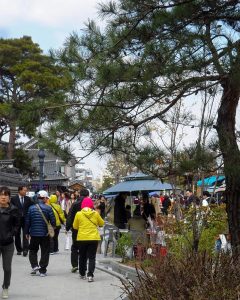
We also had to queue to get into a restaurant for dinner. It was worth it though as the galbi and bibimbap we had were delicious. People seem to eat out quite early, so the later you go to eat, the quieter it should be.
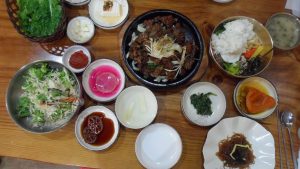
If you stay at the Benikea and have a car, there is a complicated route you have to take to drive to the underground car park (one way, pedestrianised streets, Saturday night traffic). The car park is the most bijoux and stressful parking area imaginable.
If you want to buy postcards, we never found any and just ended up with arty cards.
It is a lot cheaper if you don’t eat out in the hanok village.
On Sundays, things don’t seem to really get going, ie open, until about midday.
